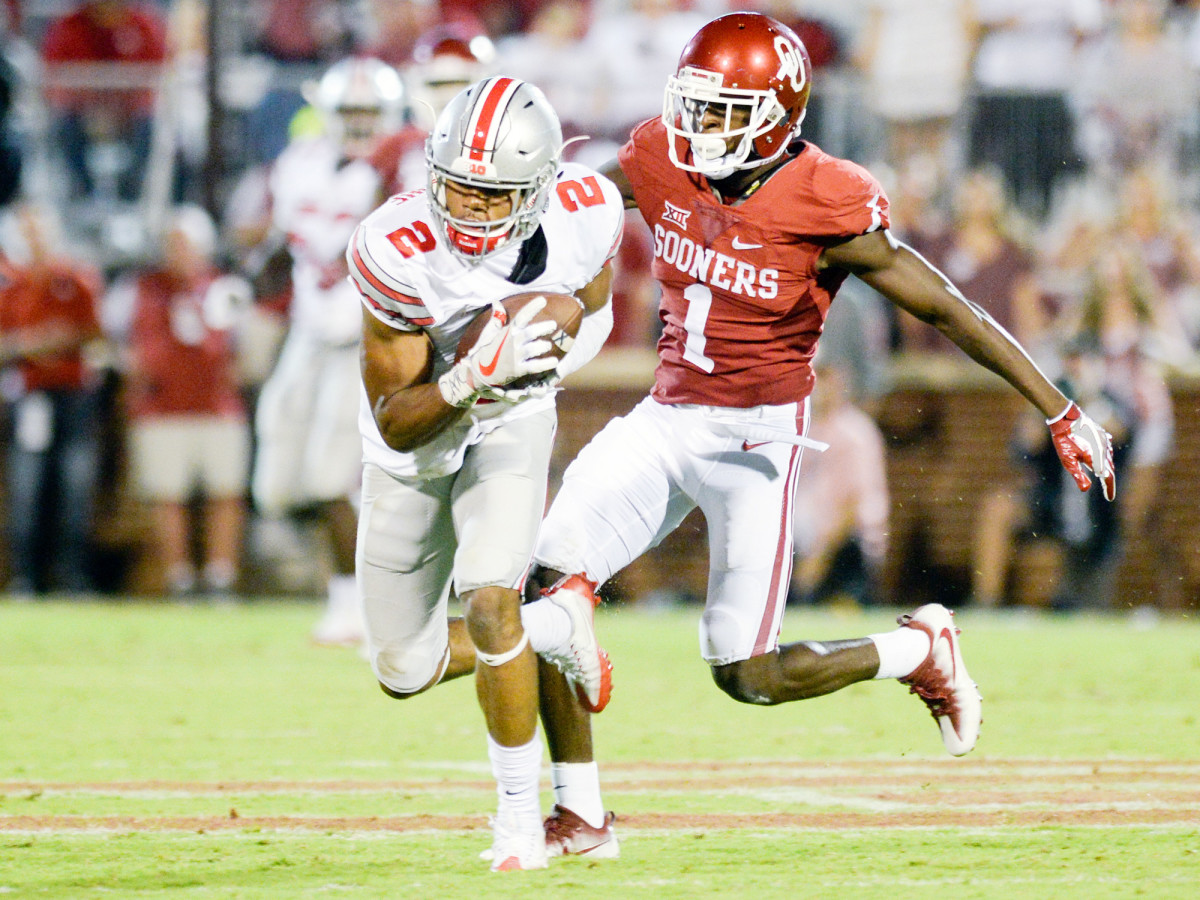College Football Playoff committee takes stand for tough non-conference scheduling

As the College Football Playoff selection committee spent Saturday night and Sunday morning choosing the teams that would make the sport’s final four, two separate arguments raged in the college football-loving world. Only one of them mirrored a discussion in the committee room.
Argument No. 1: Ohio State should not make the playoff over Penn State because Penn State beat Ohio State and won the Big Ten title. This is a philosophical discussion.
Argument No. 2: Washington should not make the playoff over Penn State because Penn State’s résumé is better than Washington’s. This is a judgment call.
Based on where Ohio State ended up (No. 3), we can conclude the committee didn’t have argument No. 1 because it considered the Buckeyes’ résumé better than the Nittany Lions’ résumé. Based on where Washington (No. 4) and Penn State (No. 5) ended up and based on the statements of committee chair Kirby Hocutt, we know the committee had argument No. 2 and concluded that it felt Washington had the better résumé.
“As the selection committee, we come back to our charge, our focus and our mission,” Hocutt told ESPN on Sunday. “That is to select the four very best teams in college football. We talk about the metrics that are provided to us when there are two teams that are comparable to one another: conference championships, strength of schedule, head-to-head outcomes, games against common opponents. All of that matters to the selection committee.” Translation: The committee doesn’t attach the mystical significance to a conference title that a lot of fans do, probably because the members of the committee work in the sport and understand unbalanced schedules in huge leagues have diluted those titles.
Roundtable: Did the College Football Playoff committee get it right?
That a conference title and head-to-head win didn’t put Penn State in over Ohio State tells us that the committee didn’t consider their résumés comparable, and there is only one obvious reason why. The committee chose the option that will pay dividends in the future for those of us who enjoy good football games* because the inclusion of Ohio State will inspire athletic directors to schedule more good football games. The Buckeyes are in the playoff because they went to Norman and hammered eventual Big 12 champ Oklahoma on Sept. 17. Had they opted to play Akron that week, they’d be prepping for the Rose Bowl and Penn State would be headed to the playoff. “The selection committee respects that type of scheduling and those wins that come from those type of non-conference games,” Hocutt said.
*The best option to deal with all these arguments remains expanding the playoff to eight teams. The commissioners would demand automatic bids for the Power 5 champs, leaving either three or two—if the top Group of Five champ got an automatic bid—wild cards. This would satisfy the CONFERENCE CHAMPIONSHIPS MEAN EVERYTHING crowd and protect the highly lucrative conference title games. It also would take care of good teams denied conference titles by weird circumstances or by a fluky loss. Contrary to the tired argument, this would not hurt the regular season. The top teams would be playing for seeding and home games, while the next group would be playing for survival. More games would matter because more fan bases would remain engaged. This will happen eventually once the Big 12 figures out that it’s the simplest solution to its problem of getting left out of the playoff. The SEC doesn’t care; its attitude is more spots equal more SEC teams in the playoff. The ACC will do whatever the SEC does. The Big Ten would fight this, but it shouldn’t. This year, it would have gotten three teams in.

But, you say, didn’t Oklahoma scheduling Ohio State cost the Sooners a playoff berth? And didn’t Penn State scheduling Pittsburgh cost the Nittany Lions a playoff berth? And didn’t Washington get in having played only Rutgers, Idaho and Portland State in the non-conference?
These are fair questions, but consider this. Oklahoma would have gotten in instead of Ohio State had it won the game. (And Oklahoma’s win at Tennessee in 2015 helped the Sooners grab the No. 4 spot in the playoff.) Penn State would have gotten in over Washington had it beaten Pittsburgh.
The risks and rewards attached to these games are huge, as they should be. Winning them should matter. By crossing the conference champion Rubicon on Sunday, the committee made the strategy of “schedule a bunch of cupcakes and pray to win the conference title” a trickier proposition going forward. If the committee had kept including only conference champs even when some non-champs had better résumés, Power 5 schools would have loaded up on easy wins because four of the five Power 5 champs would get in every year. A conference title would have given those teams an 80% chance of making the playoff, so why on earth would a team risk a loss in the non-conference? Now, there is proof that a great non-conference win can erase a slip during the conference season. That’s a huge incentive to schedule a game that we’ll enjoy watching.
Penn State's title game win a testament to Big Ten's strength, bright future
This also may be a bit of a course correction informed by what happened last year. While hardly anyone complained when the bracket was revealed last season, revisionist history has not looked kindly on Big Ten champ Michigan State’s 38–0 loss to Alabama in the Cotton Bowl. Would Ohio State and its 10 players who would get drafted in the first three rounds have given the Crimson Tide a better game? Probably. But Michigan State had the head-to-head, a conference title and a non-conference win against Oregon. Ohio State’s best non-conference opponent was Virginia Tech, which won three fewer games in the regular season than the Ducks. The Spartans simply had a better resume. Had Ohio State beaten, say, Stanford in the non-conference last year, the committee might have had more on which to chew. The message is now clear: Schedule better games, win those games and you enhance your chances.
That’s how Ohio State got in this season. The Buckeyes could have feasted on a cupcake on Sept. 17. Instead, they scheduled a game that created a hot ticket in Norman and a no-brainer primetime broadcast. They won it, and it buoyed them even after they lost to the exact wrong team in conference play for a second consecutive season. Everybody won in that scenario except Oklahoma, which probably would have enjoyed similar spoils—only the loss erased would have been a non-conference game against Houston—had it emerged victorious that night.
The four-team playoff remains the half-measure between the BCS and the eight-team playoff the sport should have had all along, but at least the committee has voted in a manner that will benefit the sport down the road. So put down those cupcakes, athletic directors, and make more quality non-conference games happen. One might be the difference between making the playoff and watching the playoff from home.
A random ranking
Regina Ham, who produces my Sunday night show on SiriusXM’s College Sports Nation channel, asked for a ranking of french fries. These will be highly controversial.
1. Chick-fil-A waffle fries
2. Checkers/Rally’s seasoned fries
3. Arby’s curly fries
4. McDonald’s
5. Five Guys cajun fries
Big Ugly of the Week
This week’s winner is 301-pound Wyoming defensive tackle Sidney Malauulu, who did this in the Cowboys’ Mountain West Conference title game loss to San Diego State.
Get up, Sidney Malauulu! The big man...with the pick! #GoWyo pic.twitter.com/1BjuLURcSO
— Wyoming Cowboy Football (@wyo_football) December 4, 2016
Malauulu has an intriguing backstory. He played only one year of high school football in Arizona because he spent seventh through 11th grade in Seoul, South Korea, where the U.S. Army had his father stationed.
First-and-10
1. The playoff grabs all the headlines, but the other bowl matchups were also setSunday. Here are the five most intriguing games outside the playoff.
Florida State vs. Michigan in the Orange Bowl
Two pro-style offenses and two athletic defenses will hammer away at one another.
Louisville vs. LSU in the Citrus Bowl
Lamar Jackson vs. a non-interim Coach O? Yes please.
Nebraska vs. Tennessee in the Music City Bowl
For the sake of Butch Jones’s sanity this off-season, the Volunteers had better win this one. So far, they’ve had great fortune against Big Ten teams in bowls under Jones.
Houston vs. San Diego State in the Las Vegas Bowl
Bid adieu to Greg Ward Jr. and Donnel Pumphrey with the sound of slot machines ringing in the air.
Virginia Tech vs. Arkansas in the Belk Bowl
Because you know it’s going to get weird.
College football bowl games schedule: All 2016–17 games, matchups, TV channels
2. Heisman ballots are due at5 p.m. ETMonday, and I’m still working on mine. I still think Louisville quarterback Jackson will win because he’ll be in one of the three spots on the majority of ballots, but the margin should be a lot slimmer than we all expected a month ago. Clemson quarterback Deshaun Watson may have made the biggest gain on championship weekend by throwing for 288 yards, rushing for 85 yards and scoring five total touchdowns in the Tigers’ 42–35 ACC championship win over Virginia Tech. He reminded everyone why he was a finalist last year and probably picked up some votes.
3. After leading Oklahoma to a Big 12 title with a 38–20 win against Oklahoma State, Sooners quarterback Baker Mayfield announced he will return for his senior season. Remember, this is possible because the Big 12 presidents voted in May to change a transfer rule. (After stupidly voting to uphold it the previous day.)
4. Tommy Tuberville resigned before he could get fired at Cincinnation Sunday, which probably means the Riverboat Gambler’s time as an FBS head coach is at an end. He’ll always have the pine box, Jetgate, the Golf Digest national title and One For The Thumb, though.
5. West Virginia coach Dana Holgorsen, who turned down a contract extension after last season because it might have cost him money if he got fired after this one, agreed to a new five-year dealSaturdayafter finishing a 10–2 season with a 24–21 win against Baylor. The five-year deal will give Holgorsen a raise to $3.5 million from $2.9 million. If he reaches the end of the deal, he’ll make $4 million a year. Unlike Holgorsen’s last deal, this one is not fully guaranteed. According to Allan Taylor of West Virginia MetroNews, West Virginia would owe Holgorsen more than $11 million if it fired him next year. That buyout drops into the $6 million range in the third year.
6. Speaking of Big 12 coaches and their contracts, Tom Herman agreed to a deal that will pay him about $28.75 million over five years.
6. Matt Zenitz ofAL.comreportedSundaythat Alabama backup quarterback Cooper Bateman has been granted his release and plans to transfer. The question now is whether Bateman will stay with the Crimson Tide through the postseason. Blake Barnett, who started Alabama’s season opener but then lost the job to true freshman Jalen Hurts, left the program in October. If Bateman leaves immediately, it would leave Alabama with only Hurts and David Cornwell on scholarship. Or Bateman could stay until the Tide finish playing. Last year, Trevor Knight got his release but remained with Oklahoma through its College Football Playoff semifinal loss to Clemson. Class of 2017 quarterback Tua Tagovailoa plans to enroll in January. Last year, Hurts joined the team during its playoff run and simulated Clemson quarterback Deshuan Watson as Alabama prepped for the national title game.
7. Speaking of Hurts, the SEC’s open locker room policy at its championship game resulted in the freshman’s first interview since winning the starting job. He already sounds like Nick Saban.
8. Let’s all watch this amazing John Ross touchdown catch just one more time.
Are you kidding?! John Ross with a sick one-handed Touchdown catch. #PurpleReign #Pac12FCG https://t.co/ovXiWH1COA
— FOX College Football (@CFBONFOX) December 3, 2016
9. Oklahoma walk-on offensive lineman Riley Nolan wrote a beautiful letter explaining what he’ll take away from his college football career.
My open letter to @OU_Football 🏈🙏🏼 pic.twitter.com/ruev0CbiGO
— Riley Blaine Nolan (@rnolan66) December 4, 2016
10. We’re going to see this get Photoshopped a lot in the next few weeks.
Swag. pic.twitter.com/ENBcrVytVx
— SEC Network (@SECNetwork) December 4, 2016
What’s eating Andy?
Just go to eight already.
What’s Andy eating?
There is a popular bumper sticker where I live that decrees “If Anything Can Go Well, It Will.” I hate this bumper sticker. The premise is ludicrous, and thousands of years of recorded history have proven it laughably incorrect. Yet saps slap it on their cars anyway.
One day a few years ago, I looked up the genesis of this bumper sticker. Somehow, its origin story manages to be even stupider than the idea that if a positive outcome is possible, that’s what will happen.
The web site run by the creator of these bumper stickers is now down—that didn’t go so well, did it?—but a Redditor typed in the backstory two years ago. This confirms I didn’t hallucinate this tale. There is a guy from the Orlando area named Gene. One day, he was in a bad mood because he wanted to go from one of his mother’s (multiple) houses to another of his mother’s (multiple) houses, and he’d forgotten the keys. So he had to drive back and get them. Along the way, he began thinking about Murphy’s Law. He decided if he took the attitude opposite of “If anything can go wrong, it will,” then the Sisyphean task of driving an extra half hour might not seem so awful. Shortly afterward, Gene’s new philosophy was confirmed when his trust fund kicked out some cash. Gene’s Law was born. So Gene decided to create bumper stickers that idiots would later use to cover dents.
Yes, Gene. Things typically will go well when mom owns multiple houses and you have a trust fund. The rest of us have a slightly different experience. If we simply assume things will go well and don’t take the action required to makethings go well, then the world will beat us mercilessly. That’s probably why your bumper stickers don’t usually adorn many new cars.
What does this have to do with food? I was thinking about Gene’s Law as I drove through Atlanta recently. I was in a bad mood for a silly reason, so I cycled through the possible solutions to put myself in a more optimistic frame of mind. Blindly assuming everything would go well obviously wasn’t an option. I needed a more tangible option. Fortunately, Homegrown GA was only a few miles away.

The most popular item on the menu at Homegrown GA is the Comfy Chicken Biscuit. A tote board just to the left of the counter of this diner/Five-and-Dime store counts how many the place has served since it opened, and that number continues to skyrocket. The concept is simple. A fried chicken breast sits atop an open-faced biscuit. Chicken and biscuit are then covered in milk gravy. There is no fancy twist, no chef trying to take ownership of the dish by inserting kale or truffle oil. It’s just a fried chicken biscuit covered in gravy, and it’s beautiful.

But that isn’t all you should order. To truly eat all your feelings, add a side of cheddar chili home fries. I get that some of you vehemently dislike home fries, but that doesn’t mean I have to care or understand. Home fries are just potato chunks cooked in whatever seasoning is left in the pan after the main course is finished. They’re no better or worse than hash browns, and they’re especially adept at soaking up chili without getting soggy. The home fries at Homegrown GA had a crisp, tasty crust that paired perfectly with the fiery chili. This dish would have made an excellent main course had it not come alongside an even better one.
The meal was the ultimate mood booster. I left feeling much fatter yet considerably lighter. So I’m decreeing that from this point forward, Andy’s Law will be this: Everything may go wrong, so just eat biscuits and gravy. Now let’s go make some bumper stickers.
